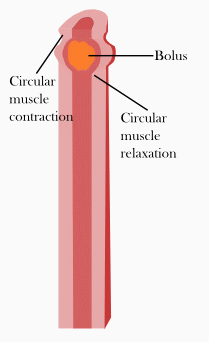- When you put food in your mouth
- Chewing food is called mastication
- The Salivary Glands releases saliva into the mouth to lubricate and then you swallow and it goes down your oesophagus

JOHN KEY!!
- The food is 'pushed' down the oesophagus to the stomach by waves of muscle contractions. This process is called Peristalsis

- The Stomach Can Hold 2 - 4 litres of fluid and is able to expand and take more food to protect us from scavengers
- The Stomach holds very dangerous acids and can hurt you if you throw up too much
- The pH of the acids are around 1 - 2
Digestion - The Small Intestine
- The pH in the small intestine is usually 7 - 9
- The walls are lined with small finger-like projections called villi which increase the surface area of the small intestine
- These villi are covered in microvilli which again increase the surface area of the small intestine
- With a larger surface area, the food nutrients can be absorbed quicker

- The liver is the second largest organ in the human body after the skin
- After they are digested, the nutrients are absorbed and transported to the liver via the Hepatic Portal Vein
- The liver creates bile which is then stored in the gall bladder
Absorption
Egestion
No comments:
Post a Comment
Note: only a member of this blog may post a comment.